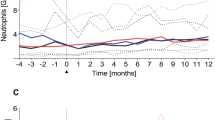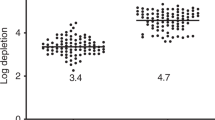Abstract
A number of different alkylating chemotherapeutic agents--busulphan, dimethylbusulphan (DMB), isopropylmethane sulphonate (IMS), melphalan, cyclophosphamide (CY) and bischloroethylnitrosourea (BCNU)--were investigated for their cytotoxic effects on different haemopoietic cell populations in host mice and for their ability to induce short- and long-term engraftment of transplanted bone marrow. At 24 h after drug treatment the femoral content of transient and permanent repopulating stem cell subsets was assessed, respectively, from the frequency of early- (day 5-15) and late- (day 25-35) developing cobblestone area-forming cells (CAFCs), growing in vitro in long-term bone marrow cultures (LTBMCs). At this time a fixed complement of 10(7) congenically marked donor bone marrow cells (B6-Gpi-1a-->B6-Gpi-1b) was infused in the drug-treated mice and erythroid engraftment was followed over 36 weeks. Diverse effects on early- and late-developing CAFC frequencies were found for the different drugs; these were generally related to the pattern of donor bone marrow engraftment in treated recipients. Melphalan was more toxic to early-developing than to late-developing CAFC subsets, and the transplant only offered an early wave of blood chimerism followed by return of host cells. CY and BCNU had minimal to moderate effects on CAFC content and engraftment with no apparent preference for any particular haemopoietic cell subset. IMS also had a relatively low toxic effect on host marrow CAFC frequencies but appeared exceptional in its ability to allow for more donor-type engraftment. The dimethane sulphonate compounds busulphan and DMB were especially potent at depleting late CAFC subsets and ensured high and lasting levels of donor bone marrow engraftment. These studies support the value of CAFC measurements for predicting the fate and growth of transplanted bone marrow cells in recipients pretreated with a variety of cytotoxic agents.
This is a preview of subscription content, access via your institution
Access options
Subscribe to this journal
Receive 24 print issues and online access
$259.00 per year
only $10.79 per issue
Buy this article
- Purchase on Springer Link
- Instant access to full article PDF
Prices may be subject to local taxes which are calculated during checkout
Similar content being viewed by others
Author information
Authors and Affiliations
Rights and permissions
About this article
Cite this article
Down, J., Boudewijn, A., Dillingh, J. et al. Relationships between ablation of distinct haematopoietic cell subsets and the development of donor bone marrow engraftment following recipient pretreatment with different alkylating drugs. Br J Cancer 70, 611–616 (1994). https://doi.org/10.1038/bjc.1994.359
Issue Date:
DOI: https://doi.org/10.1038/bjc.1994.359
This article is cited by
-
The effect of modulation of glutathione cellular content on busulphan-induced cytotoxicity on hematopoietic cells in vitro and in vivo
Bone Marrow Transplantation (2002)
-
Influence of O6-benzylguanine on the anti-tumour activity and normal tissue toxicity of 1,3-bis(2-chloroethyl)-1-nitrosourea and molecular combinations of 5-fluorouracil and 2-chloroethyl-1-nitrosourea in mice
British Journal of Cancer (1999)
-
Reduced bone marrow stem cell pool and progenitor mobilisation in multiple myeloma after melphalan treatment
Medical Oncology (1999)



